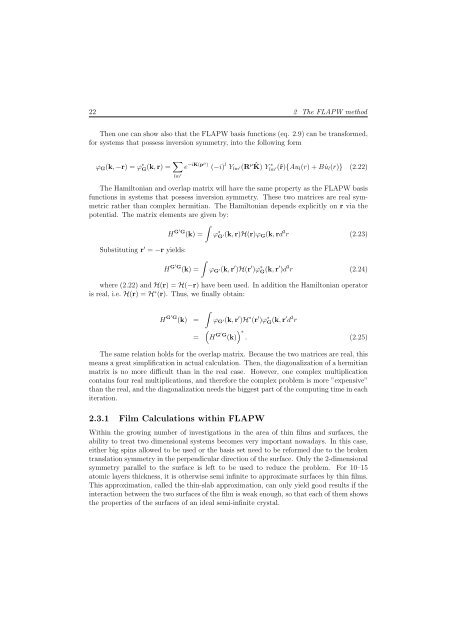Ab initio investigations of magnetic properties of ultrathin transition ...
Ab initio investigations of magnetic properties of ultrathin transition ...
Ab initio investigations of magnetic properties of ultrathin transition ...
Create successful ePaper yourself
Turn your PDF publications into a flip-book with our unique Google optimized e-Paper software.
22 2 The FLAPW method<br />
Then one can show also that the FLAPW basis functions (eq. 2.9) can be transformed,<br />
for systems that possess inversion symmetry, into the following form<br />
ϕG(k, −r) =ϕ ∗ G(k, r) = �<br />
lm ′<br />
e −iK(pμ ) (−i) l Ylm ′(Rμ ˆK) Y ∗<br />
lm ′(ˆr){Aul(r)+B ˙ul(r)} (2.22)<br />
The Hamiltonian and overlap matrix will have the same property as the FLAPW basis<br />
functions in systems that possess inversion symmetry. These two matrices are real symmetric<br />
rather than complex hermitian. The Hamiltonian depends explicitly on r via the<br />
potential. The matrix elements are given by:<br />
H G′ �<br />
G<br />
(k) = ϕ ∗ G ′(k, r)H(r)ϕG(k, rd 3 r (2.23)<br />
Substituting r ′ = −r yields:<br />
H G′ �<br />
G<br />
(k) = ϕG ′(k, r′ )H(r ′ )ϕ ∗ G(k, r ′ )d 3 r (2.24)<br />
where (2.22) and H(r) =H(−r) have been used. In addition the Hamiltonian operator<br />
is real, i.e. H(r) =H ∗ (r). Thus, we finally obtain:<br />
H G′ G (k) =<br />
=<br />
�<br />
ϕG ′(k, r′ )H ∗ (r ′ )ϕ ∗ G(k, r ′ d 3 r<br />
�<br />
H G′ �∗ G<br />
(k) . (2.25)<br />
The same relation holds for the overlap matrix. Because the two matrices are real, this<br />
means a great simplification in actual calculation. Then, the diagonalization <strong>of</strong> a hermitian<br />
matrix is no more difficult than in the real case. However, one complex multiplication<br />
contains four real multiplications, and therefore the complex problem is more ”expensive”<br />
than the real, and the diagonalization needs the biggest part <strong>of</strong> the computing time in each<br />
iteration.<br />
2.3.1 Film Calculations within FLAPW<br />
Within the growing number <strong>of</strong> <strong>investigations</strong> in the area <strong>of</strong> thin films and surfaces, the<br />
ability to treat two dimensional systems becomes very important nowadays. In this case,<br />
either big spins allowed to be used or the basis set need to be reformed due to the broken<br />
translation symmetry in the perpendicular direction <strong>of</strong> the surface. Only the 2-dimensional<br />
symmetry parallel to the surface is left to be used to reduce the problem. For 10–15<br />
atomic layers thickness, it is otherwise semi infinite to approximate surfaces by thin films.<br />
This approximation, called the thin-slab approximation, can only yield good results if the<br />
interaction between the two surfaces <strong>of</strong> the film is weak enough, so that each <strong>of</strong> them shows<br />
the <strong>properties</strong> <strong>of</strong> the surfaces <strong>of</strong> an ideal semi-infinite crystal.

















